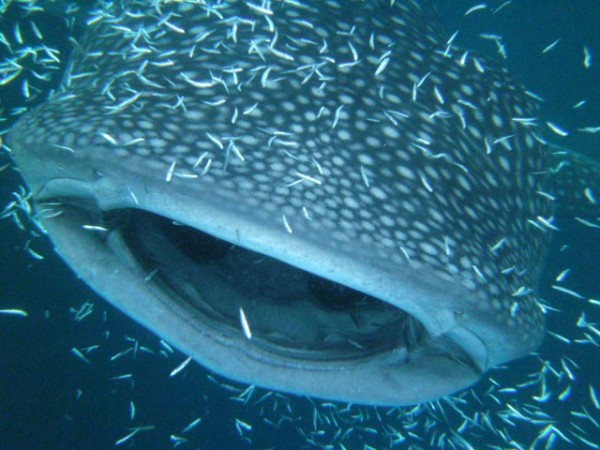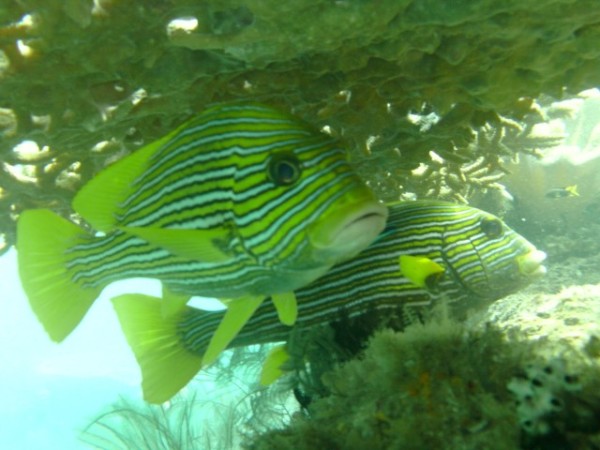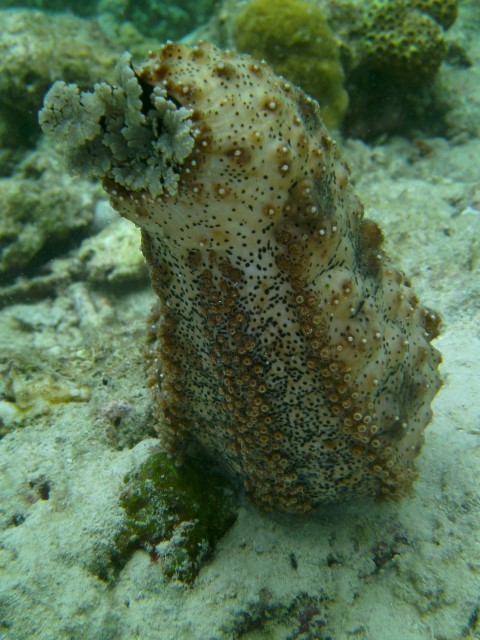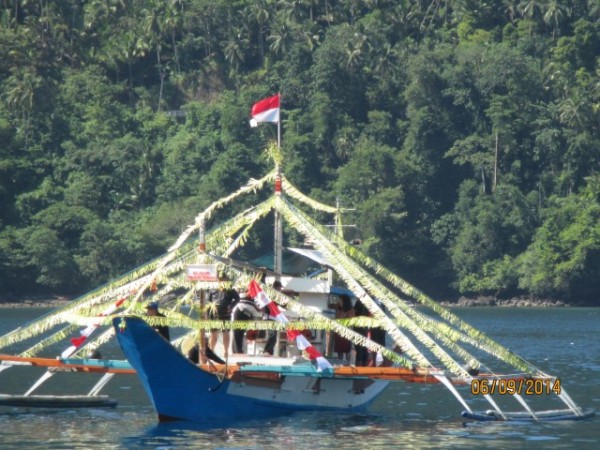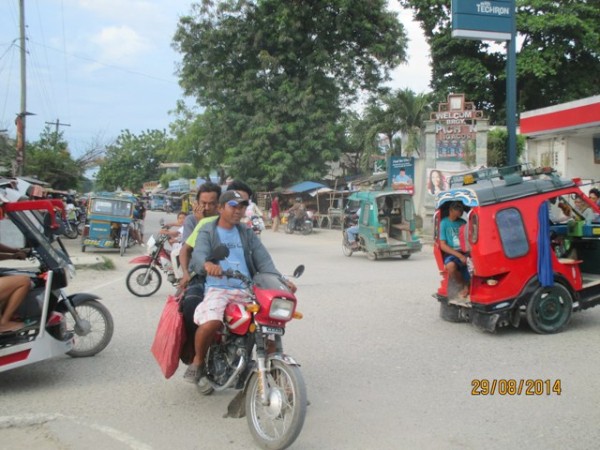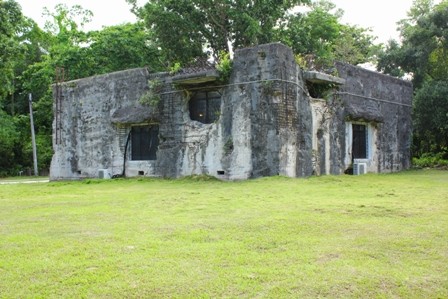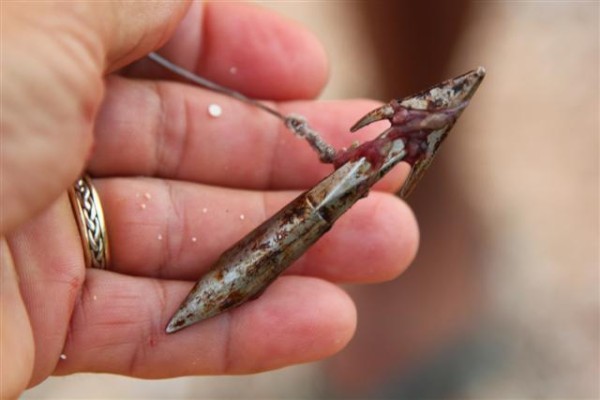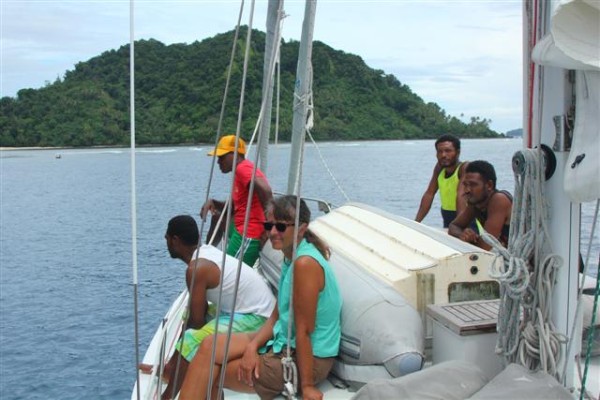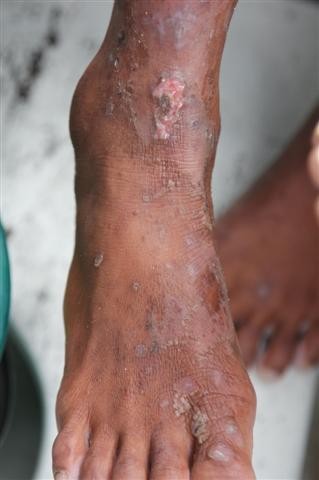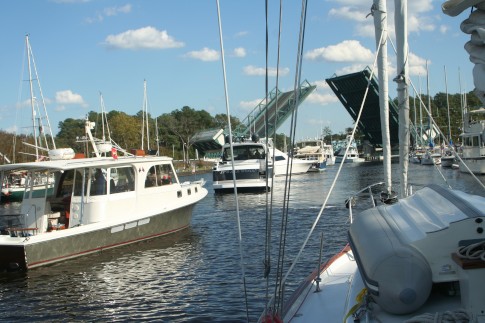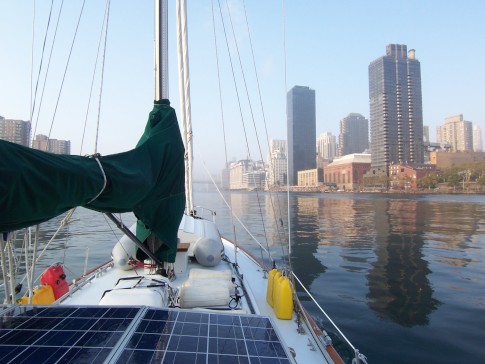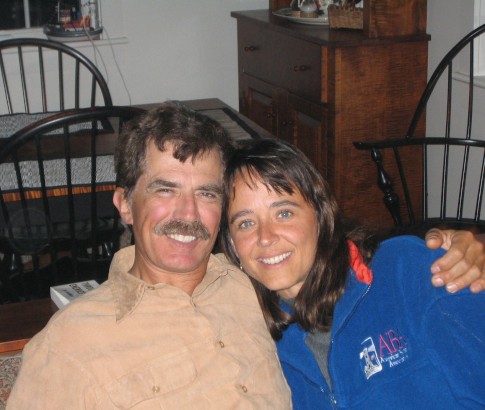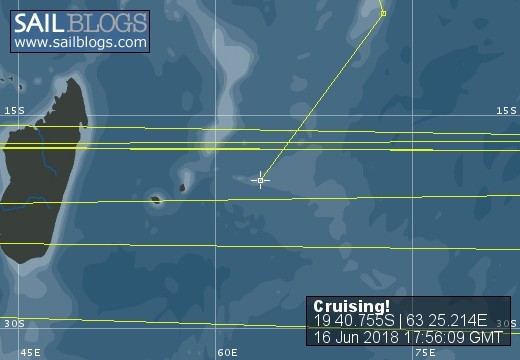
Where WAS Brick House...The First Eight Years
Please visit our NEW WEB SITE: http://WhereIsBrickHouse.com
20 April 2016
05 October 2015 | Malaysia, island of Borneo
19 September 2015 | Kuching/Santubong
30 July 2015
01 July 2015 | Bali, Indonesia
23 May 2015 | Bali, Indonesia
17 April 2015 | Venu Island
01 April 2015
12 March 2015 | Tioman
01 March 2015 | Papua, Indonesia
26 February 2015 | West Shore of Papua Indonesia
21 January 2015 | Raja Ampat, Indonesia
05 January 2015 | Gam and Waigeo, Raja Ampat
31 December 2014 | Misool, Indonesia
31 December 2014 | Masool, Indonesia
24 December 2014 | Indonesia
21 October 2014 | Philippines
04 June 2014 | Davao
17 April 2014 | Pacific
03 March 2014 | Pacific
Castle Island - Then and Now
19 February 2008 | Anchored at Castle Island, Far SE Bahamas
Patrick Childress

Castle Island
In 1979 somewhere south east of Nassau I met up with Kurt, a Canadian who was single handing a Grampian 26. I was on my Catalina 27. We sailed on, side by side, through the Bahamas and onto the Virgin Islands. Together, we have lots of war stories. In late February, we stopped at Castle Island off the southern tip of Acklins Island.
Five years previous to our sail through the Bahamas, the light houses were automated. The keepers buildings were boarded and padlocked. Fresh water could be had at the cisterns so it was always worth anchoring to visit a lighthouse. It is a very rolly anchorage at Castle so when we stopped we did not expect to be there more than overnight.
This is what was written in the log book in late February 1979:
"Pulling the dinghy high up on the sand, our attention was grabbed by what looked like a large bed sheet hanging from the top circular rail of the light at least a hundred feet above us. We thought it obnoxious that someone would hang trash to show the world. On our way up from the beach 3 goats bounded from their sunning spot on a concrete walkway and vanished into the thickets. Weeks of seafood and canned food, I suddenly had the taste for red meat. We decided to climb the lighthouse and spot where the goats had run off to. As we passed between the outbuildings, we grabbed the lid on top the water cistern and slid it to the side. It was full of clear fresh water. The wooden outbuildings all had broken locks and open doors. In the middle of nowhere, I couldn't understand why such buildings would be locked, but could understand less, what would motivate someone to vandalize empty buildings. It look as though people had been camping in the old houses but recently left. The door at the base of the lighthouse was open, blowing in the wind. We climbed and climbed in ascending circles, our feet echoing with each step, till we reached the glass dome from where the rotating beacon shone. Looking across the scrub, we could see the entire island including the two lakes to the north east. The large white thing hanging from the steel rail is a jib sail. It was ripped, but the hanks, although large, would be cut loose and saved as spares on Bonnie Jean and Juggernaut. We let the sail flutter to the ground. The sail would be saved as patch material. We scanned the island vegetation for the escaping red meat. They were smart animals to stay well hidden amongst the 8 foot tall thorn bushes and briers of the island. But far along the white sandy beach stretching a mile to the south east, we could just make out a large, odd, blue object, high up on shore. It looked like a painted piece of plywood. The shape was not a natural part of the environment. It was an attraction to two young explorers with a lot of time on their hands. It was a long trudging walk through a soft sand and cloudless sky. As we approached, the odd shape became a starboard fiberglass hull section of a sailboat. Shiny stainless steel chain plates still attached. A short distance up the sand was the bow, full of deck and through-hull fittings. Looking out over the shallow reefs, there was no other sign of a wreck. Our excitement quickened as we were the first to discover this treasure. We were alone on the island but still felt a need to walk quickly back to our anchorage and gather up wrenches and saws and snorkeling gear. We could not imagine what other treasures were waiting to be found. On the way back to our boats, we stopped to pick up the old sail we had dropped to the base of the lighthouse. Only now did we realize what helped to make the sail appear old, was paint, in the shape of very large letters, SOS. Back at the dive site, Kurt and I entered the water near the hull section and swam from the beach in different directions. Two minutes later, I found freshly damaged coral 6 feet from the surface. The boat had bounced shore ward over shallow spots then floated easily in 15 feet of water before smashing into the next hard shoal. Kurt was standing on waist deep coral yelling excitedly. Swimming in his direction, the path of coral destruction continued. The shallow reef opened below Kurts feet into a sandy hole ten feet deep and thirty feet circular. There it lay, in a basket of sand, the smashed remains of the 35 foot ketch, Le Pellican 2 from Quebec, Canada. It was a sad and moving sight. Amongst the smashed bits, I could see the head had been decorated with tiny ceramic tiles. The heavy diesel engine was spotless and shiny. Ripped sails, still attached to the mast, lay undulating like wings of a dieing stingray flapping at the sand. Some ones dream lay in pieces below one of the brightest lighthouses in the Bahamas. Amid this tragedy, the bright sparkle of two speed winches and deck hardware shone like silver. It was valuable equipment we could fasten to our own sailboats. Who ever lost this boat was able to carry much away. Kurt and I would take what was bolted down. Without SCUBA gear, salvaging is difficult work. Taking a deep breath , we would dive down and wrap a leg or arm around something solid. The weather was calm but there is always a rhythmic surge passing over the reef. Undulating with passing waves, the timing had to be precise to place a wrench on a nut, or slip a screw driver in a slot, and keep it there. Only enough air remained in the lungs to get 3 or 4 rotations before it was mandatory to surface and start the process again. Some screws were stubborn, They took 4 or 5 dives just to free up so they would begin to turn. By the end of the day, we made some progress. We left our tools deep into the island brush above the beach and carried a sack full of hardware back to our anchorage. The next morning as we continued our salvage work, two Bahamian fishermen perched in a rickety, flat bottom boat with a small outboard churning up water on its stern, floated into our salvage area. The Bahamians soon found the wreck and anchored over it. They had heard several people had been stranded for a week on the island when their boat had run aground. The Bahamians only salvage tools were their long poled conch hooks and a glass bottom bucket. They snagged rope and rubber hoses and whatever else they could lift to the surface. While diving repeatedly on a winch, I watched these men snag the rigging of the mizzen mast. For ten minutes they held steady to this treasure unable to budge it closer to the surface. Still fastened to heavy pieces of hull, there was no way in the world the mast and boom would ever be coaxed free. I swam over to help. I released clevis pins then moved debris and untangled wires. In two hours, the Bahamians had balanced across their boat a perfect mast and boom with stainless steel rigging and fittings. There were parts on that rig I would liked to have for my own boat but the use for that complete rig, by these two men, far outweighed my need. Most Bahamian sailboats have fairly straight tree trunks and branches for spars, old barbed wire for rigging. This is a treasure which would improve their lives. It took another full day to recover what we could from the wreck. The work was also cut short by strong north winds which moved in overnight. We flipped a coin which gave Kurt first choice of the new equipment then we proceeded to take turns choosing till we had two piles of gear. 350 pounds of lead pigs now filled Juggernauts bilge. Hopefully the added weight would slow the miserable rocking while at anchor. Immediately I disassembled and cleaned a Gibb two speed winch then installed it on my mast for the jib halyard. Also I installed my new boom vang. Despite all the work put into Juggernaut in Miami, upgrades and repairs would continue for most of the voyage."
In September of 1981 Juggernaut was anchored in Cape Town, South Africa. At the Royal Cape Yacht Club I got to talking to a man who just returned from the Bahamas after loosing his yacht on a reef lined beach under one of the most powerful light houses in the Bahamas. He said he was single handing. Sailing at night he could see the light which he would be rounding and figured he had plenty of time to go below for a little snooze. When he woke he was startled to see the light was more overhead than ahead crunch, crunch. He lost his boat only a few hundred feet from Le Pelican 2. It took 5 days before a passing yacht picked him up.
It is difficult to tell how many wrecks surround Castle Island. New additions include a small freighter on the beach below the light house and a sea plane on the north east shore. If so many wrecks can happen on an island with a 22 mile lighthouse, what has blundered onto the reefs at Mira Por Vos Cays? Por Vos lies by itself ten miles to the west. There is no lighthouse, no warning.
A castaway on Castle Island would now have a short wait before rescue. Yesterday Rebecca and I counted 2 small powerboats and a much larger charter fishing boat working the leeward dropoff. Talking to Corry, one of the fishermen who grew up on Acklins, he said fishing here was good 15 years ago but now it is very difficult to make a living. From the diving we have done around the leeward sides of Castle, we would agree.
The weather reports are contrary for a sail to Hogsty Reef, Mira Por Vos Cays is looking like a good alternative. We will probably head there today or tomorrow.
In 1979 somewhere south east of Nassau I met up with Kurt, a Canadian who was single handing a Grampian 26. I was on my Catalina 27. We sailed on, side by side, through the Bahamas and onto the Virgin Islands. Together, we have lots of war stories. In late February, we stopped at Castle Island off the southern tip of Acklins Island.
Five years previous to our sail through the Bahamas, the light houses were automated. The keepers buildings were boarded and padlocked. Fresh water could be had at the cisterns so it was always worth anchoring to visit a lighthouse. It is a very rolly anchorage at Castle so when we stopped we did not expect to be there more than overnight.
This is what was written in the log book in late February 1979:
"Pulling the dinghy high up on the sand, our attention was grabbed by what looked like a large bed sheet hanging from the top circular rail of the light at least a hundred feet above us. We thought it obnoxious that someone would hang trash to show the world. On our way up from the beach 3 goats bounded from their sunning spot on a concrete walkway and vanished into the thickets. Weeks of seafood and canned food, I suddenly had the taste for red meat. We decided to climb the lighthouse and spot where the goats had run off to. As we passed between the outbuildings, we grabbed the lid on top the water cistern and slid it to the side. It was full of clear fresh water. The wooden outbuildings all had broken locks and open doors. In the middle of nowhere, I couldn't understand why such buildings would be locked, but could understand less, what would motivate someone to vandalize empty buildings. It look as though people had been camping in the old houses but recently left. The door at the base of the lighthouse was open, blowing in the wind. We climbed and climbed in ascending circles, our feet echoing with each step, till we reached the glass dome from where the rotating beacon shone. Looking across the scrub, we could see the entire island including the two lakes to the north east. The large white thing hanging from the steel rail is a jib sail. It was ripped, but the hanks, although large, would be cut loose and saved as spares on Bonnie Jean and Juggernaut. We let the sail flutter to the ground. The sail would be saved as patch material. We scanned the island vegetation for the escaping red meat. They were smart animals to stay well hidden amongst the 8 foot tall thorn bushes and briers of the island. But far along the white sandy beach stretching a mile to the south east, we could just make out a large, odd, blue object, high up on shore. It looked like a painted piece of plywood. The shape was not a natural part of the environment. It was an attraction to two young explorers with a lot of time on their hands. It was a long trudging walk through a soft sand and cloudless sky. As we approached, the odd shape became a starboard fiberglass hull section of a sailboat. Shiny stainless steel chain plates still attached. A short distance up the sand was the bow, full of deck and through-hull fittings. Looking out over the shallow reefs, there was no other sign of a wreck. Our excitement quickened as we were the first to discover this treasure. We were alone on the island but still felt a need to walk quickly back to our anchorage and gather up wrenches and saws and snorkeling gear. We could not imagine what other treasures were waiting to be found. On the way back to our boats, we stopped to pick up the old sail we had dropped to the base of the lighthouse. Only now did we realize what helped to make the sail appear old, was paint, in the shape of very large letters, SOS. Back at the dive site, Kurt and I entered the water near the hull section and swam from the beach in different directions. Two minutes later, I found freshly damaged coral 6 feet from the surface. The boat had bounced shore ward over shallow spots then floated easily in 15 feet of water before smashing into the next hard shoal. Kurt was standing on waist deep coral yelling excitedly. Swimming in his direction, the path of coral destruction continued. The shallow reef opened below Kurts feet into a sandy hole ten feet deep and thirty feet circular. There it lay, in a basket of sand, the smashed remains of the 35 foot ketch, Le Pellican 2 from Quebec, Canada. It was a sad and moving sight. Amongst the smashed bits, I could see the head had been decorated with tiny ceramic tiles. The heavy diesel engine was spotless and shiny. Ripped sails, still attached to the mast, lay undulating like wings of a dieing stingray flapping at the sand. Some ones dream lay in pieces below one of the brightest lighthouses in the Bahamas. Amid this tragedy, the bright sparkle of two speed winches and deck hardware shone like silver. It was valuable equipment we could fasten to our own sailboats. Who ever lost this boat was able to carry much away. Kurt and I would take what was bolted down. Without SCUBA gear, salvaging is difficult work. Taking a deep breath , we would dive down and wrap a leg or arm around something solid. The weather was calm but there is always a rhythmic surge passing over the reef. Undulating with passing waves, the timing had to be precise to place a wrench on a nut, or slip a screw driver in a slot, and keep it there. Only enough air remained in the lungs to get 3 or 4 rotations before it was mandatory to surface and start the process again. Some screws were stubborn, They took 4 or 5 dives just to free up so they would begin to turn. By the end of the day, we made some progress. We left our tools deep into the island brush above the beach and carried a sack full of hardware back to our anchorage. The next morning as we continued our salvage work, two Bahamian fishermen perched in a rickety, flat bottom boat with a small outboard churning up water on its stern, floated into our salvage area. The Bahamians soon found the wreck and anchored over it. They had heard several people had been stranded for a week on the island when their boat had run aground. The Bahamians only salvage tools were their long poled conch hooks and a glass bottom bucket. They snagged rope and rubber hoses and whatever else they could lift to the surface. While diving repeatedly on a winch, I watched these men snag the rigging of the mizzen mast. For ten minutes they held steady to this treasure unable to budge it closer to the surface. Still fastened to heavy pieces of hull, there was no way in the world the mast and boom would ever be coaxed free. I swam over to help. I released clevis pins then moved debris and untangled wires. In two hours, the Bahamians had balanced across their boat a perfect mast and boom with stainless steel rigging and fittings. There were parts on that rig I would liked to have for my own boat but the use for that complete rig, by these two men, far outweighed my need. Most Bahamian sailboats have fairly straight tree trunks and branches for spars, old barbed wire for rigging. This is a treasure which would improve their lives. It took another full day to recover what we could from the wreck. The work was also cut short by strong north winds which moved in overnight. We flipped a coin which gave Kurt first choice of the new equipment then we proceeded to take turns choosing till we had two piles of gear. 350 pounds of lead pigs now filled Juggernauts bilge. Hopefully the added weight would slow the miserable rocking while at anchor. Immediately I disassembled and cleaned a Gibb two speed winch then installed it on my mast for the jib halyard. Also I installed my new boom vang. Despite all the work put into Juggernaut in Miami, upgrades and repairs would continue for most of the voyage."
In September of 1981 Juggernaut was anchored in Cape Town, South Africa. At the Royal Cape Yacht Club I got to talking to a man who just returned from the Bahamas after loosing his yacht on a reef lined beach under one of the most powerful light houses in the Bahamas. He said he was single handing. Sailing at night he could see the light which he would be rounding and figured he had plenty of time to go below for a little snooze. When he woke he was startled to see the light was more overhead than ahead crunch, crunch. He lost his boat only a few hundred feet from Le Pelican 2. It took 5 days before a passing yacht picked him up.
It is difficult to tell how many wrecks surround Castle Island. New additions include a small freighter on the beach below the light house and a sea plane on the north east shore. If so many wrecks can happen on an island with a 22 mile lighthouse, what has blundered onto the reefs at Mira Por Vos Cays? Por Vos lies by itself ten miles to the west. There is no lighthouse, no warning.
A castaway on Castle Island would now have a short wait before rescue. Yesterday Rebecca and I counted 2 small powerboats and a much larger charter fishing boat working the leeward dropoff. Talking to Corry, one of the fishermen who grew up on Acklins, he said fishing here was good 15 years ago but now it is very difficult to make a living. From the diving we have done around the leeward sides of Castle, we would agree.
The weather reports are contrary for a sail to Hogsty Reef, Mira Por Vos Cays is looking like a good alternative. We will probably head there today or tomorrow.
| Vessel Name: | Brick House |
| Vessel Make/Model: | Valiant 40 #134 |
| Hailing Port: | Middletown, RI USA |
| Crew: | Patrick and Rebecca Childress |
| Extra: | |
| Home Page: | http://www.whereisbrickhouse.com |
| Social: |
Brick House 's Photos - (Main)
Brick House Crew
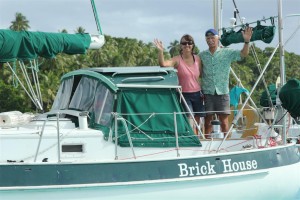
Who: Patrick and Rebecca Childress
Port: Middletown, RI USA
Where IS Brick House?!?
What Brick House Chose
- Citimarine Store
- WHAT BRICK HOUSE CHOSE
- Where Is Brick House now? (Link to Current Web Site)
- Alpenglow LED lights
- Mantus Anchor Hook
- Mantus Anchor Swivel
- SeaBreathe - Snorkelling/Boat Bottom Cleaning
- Sealife Cameras -DC1400 and Mini II
- Mack Sails for our new Genoa and Staysail
- Allied Titanium for our new Chainplates and more
- Ballenger Spars:Our new mast and rigging
- TackTick Wireless Instruments ( now Raymarine)
- Sewing Machine: Barracuda 2000U-33
- Tides Marine (STRONG) Track System
- Dry Bags- Seattle Sport Co.
- Barracuda Sewing Machine
- Sailrite for Accessories etc for most sewing machines
- ACR Electronics
- Brick House Articles Now Available
- Feathering Kiwiprop
- Our favorite Chandlery
- ProFurl Roller Furlers
- Personal AIS Transponder - Kannad Marine Safelink R10 SRS
- Vespermarine AISWatchmate
- Calibre Sails New Mainsail etc
- Edson High Capacity Pump
- Lofrans/Imtra Tigres Windlass
- RayMarine Autopilot, Chartplotter and Radar
- Navionics Charts for laptop and Chartplotter
- SHADETREE awnings
- Monitor Windvane
- Seafrost Freezer/Fridge
- Follow Our Track on Winlink
- Brick House Theme Song
- Secure WiFi Connections
- Seven Seas Cruising Organization
- Bluewater Sailing Magazine
- SAIL Magazine
- Want to Crew?



